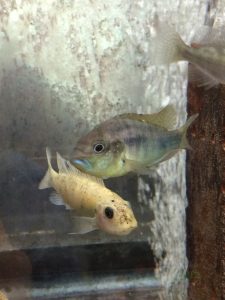 When I first found out about this specific Kenan fellowship and how it revolves around cichlids, I was excited because of all the educational lessons that could be planned from it. Quick background information: Cichlids are amazingly diverse and there are at over 1,000 scientifically described species, with more being discovered every year. If you have ever eaten tilapia, you’ve eaten a cichlid!
When I first found out about this specific Kenan fellowship and how it revolves around cichlids, I was excited because of all the educational lessons that could be planned from it. Quick background information: Cichlids are amazingly diverse and there are at over 1,000 scientifically described species, with more being discovered every year. If you have ever eaten tilapia, you’ve eaten a cichlid!
I’ve played around with a few lessons so far, such as the starting point of a divergent evolution game that capitalizes on how cichlids evolved, and a guided inquiry activity where students design and measure traits that they believe may be linked to feeding behavior among different species. The challenging part is staying focused on standards and usable lessons that can be incorporated into a specific unit. Dr. Roberts and I have discussed having a short lesson for each of the larger concepts, such as lessons in genetics, ecology and evolution that all tie together.
Because the graduate students and the postdoctoral researchers are so knowledgeable, I have also been able to bounce ideas off of them to see what would be an effective way to communicate a specific message. One potential challenge is that we are brainstorming a citizen science project, so working through the particulars of data collection and online systems, and where errors may arise is a process.
The Dr. Reade Roberts Lab is exceptionally fluid; every day, I try to come prepared ready to learn new techniques, shadow specific processes, or jump into prepping a gel to run for DNA. It has given me a valuable look into scientific lab procedures for safety and what the possibilities are. I hope to adopt this same demeanor when I express to my students how important lab processes are, and what they could be working on in the future.
